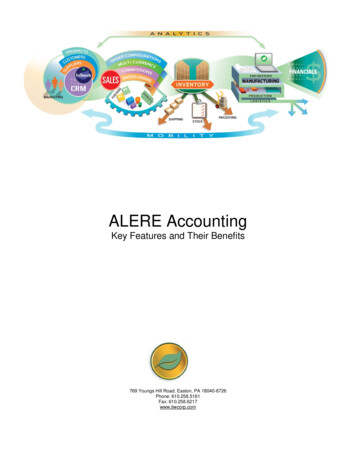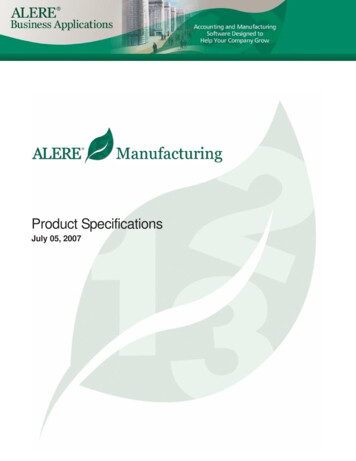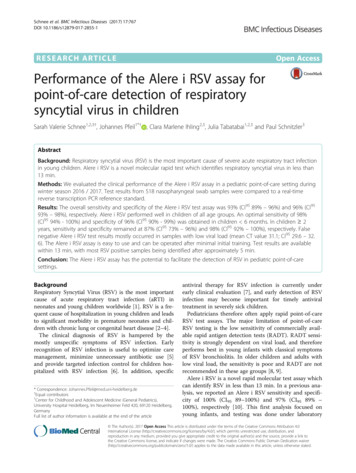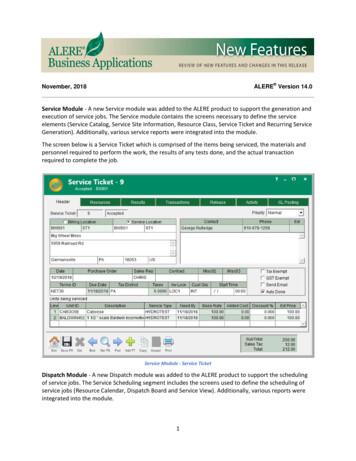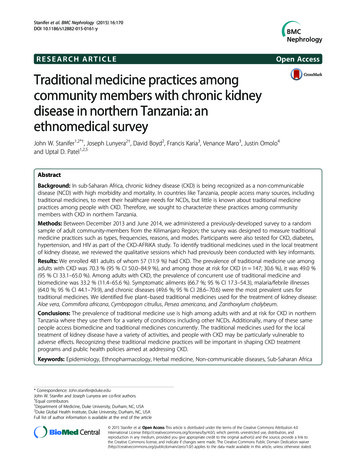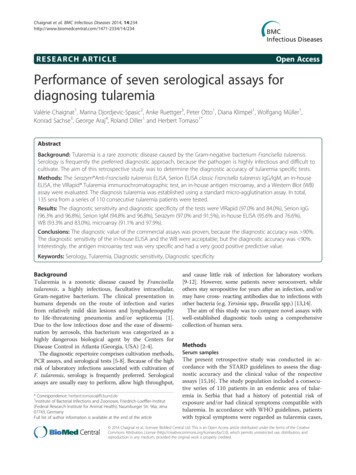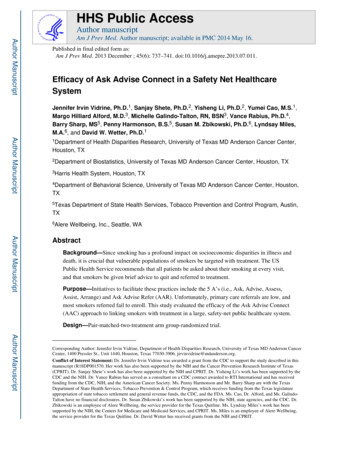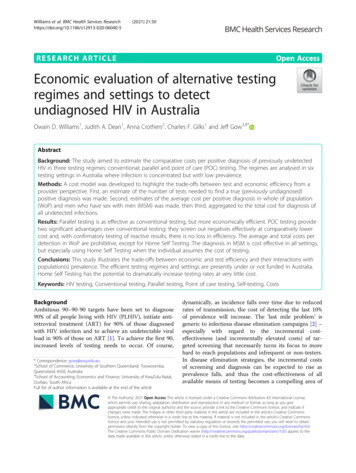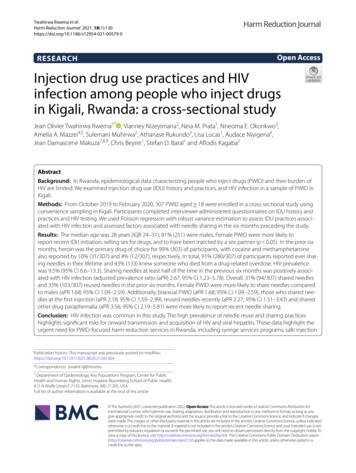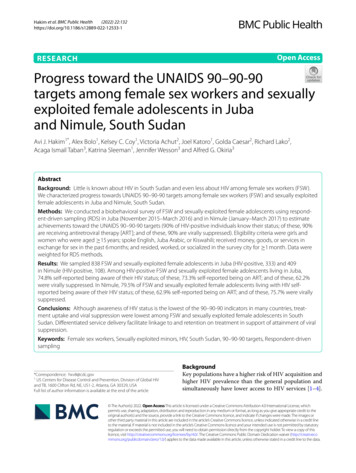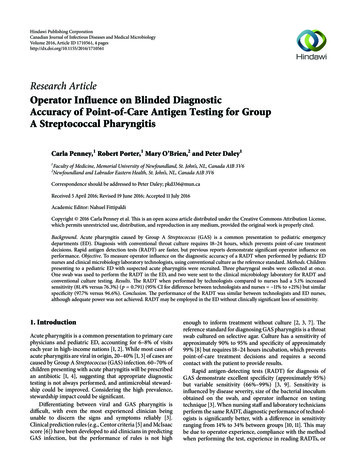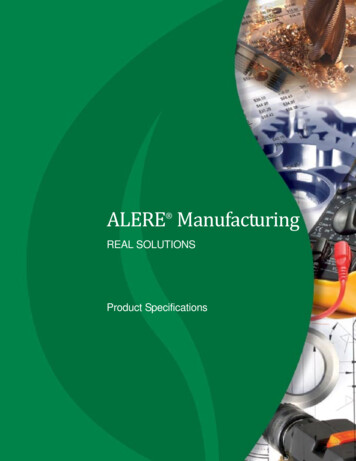
Transcription
ALERE Manufacturing REAL SOLUTIONSProduct SpecificationsPage 1
Page 2
ALERE Manufacturing is designed specifically for order driven and make-to-stock manufacturers.It includes allthe day-to-day functionality that you might expect in a sophisticated manufacturing package. What you might not expect arethe carefully designed “extras” that make it work in your environment.Modifiability – The state-of-the-art architecture ofALERE Manufacturing is written using Microsoft tools,such as SQL and VFP, uses object oriented programming (OOP), and is table driven. This means Most modifications are more quickly and easily donethan older source code-only methods. Screen sizes can be preset for each user with asimple modification requiring no code changes.MDI (Multiple Document Interface) – MDI permits youto have multiple screens open at the same time. Thisincludes screens of the same type, for instance,TABULAR SCREENSAND KEY FIELD POP UPSUPPORTOPEN MULTIPLEMODULES ATONE TIMESCREEN-ON-SCREEN(MDI) WITHHYPERTEXTGRAPHICAL ANALYSISOF KEY PROCESSESHYPERLINKSCONNECT RELATEDINFORMATION All modification can be stored in a separate directory by company. This means that if you are operating several companies, then each company couldpotentially have it’s own unique modifications.having several different work orders open. To work onany one screen, simply click on it. This helps work flowby Modifications are portable from one version toanother which saves a company from the expensiveand risky process of rewriting code. Allowing you to work on multiple, different documents at the same time, in a manner similar to theway you work at your desk.Dynamic Screen Sizing – Screens may be resized ondemand by dragging the screen larger or smaller. Anylists, notes fields or pictures on the screen are automatically sized with the screen. The key uses are Long lists can be more easily viewed and searched. Making it easy to work on a screen, be interrupted,and return to the screen to pick up where you leftoff. Permitting you to open screens with supportinginformation, which makes data entry easier. Eliminating the need to open and close modulesconstantly. More than one screen can be opened at a time andresized, which allows easy side-by-side datacomparisons to be made.Page 3
Fetch Retrieval Tool - This tool is designed to beintuitive, easy to use, and reduce the time it takes tofind information. Fetch is independent of the programmodules so it can left open on thescreen where it can be immediatelyaccessed. Fetch can be used even ifyou are in the middle of doing something else. Preset defaults. Screen sizes to fit their hardware.Hyperlinks – A Hyperlink is a relationship between two screens based oncommon information. Hyperlinks havebeen predefined throughout the systemin ALERE Manufacturing. An example oftheir use would be accessing costinformation for a work order by simplyclicking on Cost Inquiry Work OrderCost. In this case the Hyperlink looks atthe work order number and automatically gets the matching cost record. Thebenefits are as follows:Using Fetch is simple. For example, acustomer gives you his purchase ordernumber and wants to know the status ofa job you are doing for him. Enter thePO number and then select the “byCustomer PO” link. His work order isimmediately found and displayed. Supporting information for manyprocesses is only one or two mouseclicks away. Little or no training is required to usethis intuitive feature. The way in which work flows issmoother.Advanced Browser - Browsers helpfind a specific record or piece ofinformation. ALERE Manufacturingdisplays a browser each time the Getbutton is selected, the mouse is doubleleft-clicked in a key field or F2 ispressed on the keyboard in a key field.A browser provides a spreadsheet-likeview of a table of information. Eachcolumn is a field, function or a userdefinable field in the table. Each rowcorresponds to a record in the table. Abrowser allows a large amount of datato be quickly viewed. The capabilities ofthe browser are quite extensive. YoucanUSE FETCH TO REDUCETHE TIME IT TAKES TOFIND INFORMATIONExternal File Hyperlinks – These types oflinks permit external files such as drawings,pictures, documents, email, web sites, etc.to be integrated into ALERE. There are fourlink formats that can be used.www.(name) - For web sitesmailto:(address) - For emailhttp://(location) - For specific web site files Resize the browser screen to seemore lines and columns. Rearrange and resize the columns. Order the file by any column inascending or descending order. Jump to the first record matching thecharacters entered. Use relational logic to create powerful filters Display filtered records as a group orwithin the context of the entire table. Save the browser by function anduser.file:///(path) - For files on your local computer/networkThese external file hyperlinks can be placedin any memo field within ALERE. Multiplelinks can be bundled in one memo field.Global and Local Lingo – Language sets allow you tocustomize menus, screens and even different languages on a local (user-by-user) or on a global (allusers) basis. This feature will literally enable you tohave one user working in English, another userworking in Spanish, and yet a third user working withmenus designed to support only the area he or sheworks in. The benefits are obvious. When a user logsin, they can haveDiskless Workstation Installation –During the process of installing thesoftware on a server, a workstationinstallation program can be optionallyincluded. When this program is run froma workstation, it configures the workstation to run ALERE Manufacturingwithout the need to use a CD for the set up process.The benefits include Faster workstation setup. Allowing workstations without a CD drive to belinked to ALERE Manufacturing. Adding additional workstations at a later datewithout the need to find the program CD. Easy network reconfiguration. Menus designed for only them. Screens and field names unique to their business. Different languages.Page 4
The number of decimal places can be set onManager Module Reports. Bills of Material. Rounding quantity.This module provides support for housekeeping andthe common information that is shared among themodules. Highlights include:You can choose to post finished goods to inventory attheir actual cost or at their standard cost.Links to a compatible accounting system’s inventoryfile which allowsThere is support for Average, Standard, LIFO, andFIFO inventory valuation methods. The look up of inventory information. The ability to add new item numbers without leavingALERE Manufacturing. Access to key settings in inventory that are used bymanufacturing.Work orders can be automatically updated with thecalculated schedule completion date.Inventory can be optionally driven negative whenmaking material issues to jobs.Authorization to release work orders toproduction can be required.Work orders and material orders can beused at the same time in ALERE Manufacturing.Email automation allows certain pro-cesses to be set up to automatically turna report into a PDF file, attach that file toan email, add a message, and thensend it to internal staff.EXTENSIVE USERLOGIN SUPPORT WITHADVANCED OPTIONSOne email automation rule can encompass multiple different actions. As manydifferent rules can be defined as necessary.User return email addresses are definedas part of the login rights and options foreach user.There is limited inventory functionality and customerID support when ALERE Manufacturingis not linked to a compatible inventorysystem.Access to basic customer information isprovided when you are linked to acompatible accounting system.Reports for inventory and customerinformation are available.An on-line Data Dictionary details thestructure of the tables and reports inALERE Manufacturing.Many separate companies can besupported by one installation of ALEREManufacturing and the order in whichthey appear on the menu can be controlled.AUTOMATED EMAILRULES ARE FLEXIBLEAND EASILY DEFINEDPeriod closing functionality is activewhen you are linked to an accountingsystem which requires it.Multiple date formats and time formats are supportedincluding Standard Engineered Minutes to threedecimal places.An internal email system allows outgoing email to becreated and sent by ALERE instead of using an emailprogram such as Outlook.Page 5
Key changes may be made for customer, item number,labor grade, location, product class, route number, andwork center.Order ModuleThe Order Module initiates jobs in the shop, providesthe instructions and material lists for building theitems, tracks the progress of the orders and posts thefinished goods to inventory.Language Settings permit you to customize menus,screens, and even different languages on a user byuser basis.There are separate general ledger accounts for A work order can be completely processed using onlyone screen.WIP (Work In Process).Variances.Labor.Fixed Overhead.Variable Overhead.Work orders can be created:A Reconcile Balances function can be used to find andfix differences between on order and allocated quantities when ALERE Manufacturing is linked to an accounting system.The ability to assign manufacturing and inventorylocations to a group so that MRP (Material Requirements Planning) can be performed on more than onelocation. Manually from sales orders.Automatically by the MRP planning process.Manually as required to meet demand.By copying an existing order.Material lists for an order are created automaticallybased on the item being made, the BOM revisionnumber and the active date of the BOM.You can specify which route to use when creating awork order or automatically use the one associatedwith the item being made.Recovering from network relatedinterruptions is fast and easy.There is system wide packing andreindexing of files or you can selectivelychoose areas.A built-in utility checks the integrity ofindexes.Security is company based. This meansthat a user’s access to individualcompanies can be controlled. Only thecompanies that a user is authorized toopen are shown on the company menu.CREATE, PROCESS &COMPLETE WORK ORDERON ONE SCREENExtensive security capabilities that can Require passwords based onscreens. Require passwords based on usersby functions. Allow no access, password access,unlimited access or read only access privileges. Have expiration dates on rights. Enforce minimum password size. Keep a history of password use to prevent reuse.A screen provides a list of all users logged into thesystem.Labels for customer mailings, finished good information, material items for work orders, and lot/serialnumbers with item information and bar codes can beprinted.A built-in modification tool enables the label, reportsand even simple screen layouts to be customized.The projected finish quantity is automatically calculated when the starting quantity is entered or thestarting quantity is automatically calculated when thefinished quantity is entered based on shrinkagefactors.Entering a Start Date controls the earliest date anorder will be scheduled to be begin when forwardscheduling is used.Entering a Needed By date controls the start date ofan order when backwards scheduling is used.Each order’s expected completion date is automatically updated whenever a new schedule is implemented.There are three miscellaneous fields available forwork orders. Each filed can be easily named andPage 6
without releasing it for scheduling.A separate tab on each work orderscreen tracks the material that hasbeen issued to the job and the materialthat is remaining to be issued.The list of material on an order mayhave items added, quantities edited,and items deleted in real time withallocation support.EDIT MATERIAL LIST, ROUTE& CONFIGURATION ONWORK ORDERcustomized to enter text, date, or numeric information.Each order can be assigned one of a number ofdifferent priority levels which will be used to set theorder in which it is scheduled.Any item may be returned to inventoryfrom a work order regardless if it is onthe material list or not.An item on an order can be speciallydesigned using the configurationcapabilities built into the BOM. This permits one itemnumber to be built in a number of different configurations.Orders are released to manufacturing by following anFPO (Firm Planned Order) process.Several types of orders are supported: Any inventory item may be issued to awork order regardless if it is on thematerial list or not.AssembleBuildMaintenanceReworkWork OrdersThe FPO process permits password control over whohas permission to release orders.During the FPO process the item being manufacturedYou can specify that an order is to useonly the work centers specified on theroute or is to use alternate work centersif they will speed up the process.Individual orders can be set to use Forward scheduling techniques tocomplete orders as soon as possible. Backward scheduling techniques tostart the order as late as possibleand still meet the required date.Entering an Overlap Quantity on anorder sets the number of pieces to becompleted on a route step before thenext step is started. This significantlycompresses the time it takes to complete a job.MASS TRANSACTIONSSTREAMLINE MANYFUNCTIONSRoutes may be altered on work ordersthat are in process. This includes beingable to exempt steps from scheduling that might onlybe for informational purposes for example or addingsteps for rework or other purposes.The list of materials for a job is automatically allocatedin inventory when the job is released for production.Changes to a bill of material that affect the materialsassigned to a route generate a warning to update theroute/material assignment.Material staging allows material to be issued to a jobis placed on order, and the materials required to makeit are allocated in inventory.Mass transaction processes are available for mass: Page 7Firm Plan Ordering of ordersIssuing material to ordersPosting labor to ordersIssuing and returning material on ordersCompleting ordersCancelling orders
The FPO process permits lot/serial numbered materialto be specifically allocated to a job.Route ModuleOrders use transactions toThe Route Module is responsible for creating andmaintaining the instructions used for manufacturingitems. Indicate which steps have been started and completed. Issue material. Undo material issues. Post labor. Record machine time. Track work in process. Account for scrap. Change the quantity being produced. Post finished goods to inventory.Master routes are created and stored in a library filewhere they can be used on work orders.An unlimited number of master routes can be maintained.Operation steps for routes can be defined and storedin an Operation Library.Transactions may be posted to a job by Manually entering them on the work order. Batch entering them on a screendesigned for rapid data entry. Using a data collection system tocollect the transactions and postthem through an external postingprogram.ID’s for lot/serial numbered material canbe assigned right on the work orderbefore being returned to inventory.Lot/serial numbered material issued toa job can be associated with the lot/serial numbered items being manufactured that used it.BUILD MASTERROUTES TO ATTACHTO WORK ORDERSA Lot/Serial Tracking report will Show all the lot/serial numberedmaterial that was used to make anitem. Show where lot/serial numberedmaterial was used. Show who purchased the lot/serial numberedfinished goods.Steps may be loaded from the Operation Library duringthe creation of a master route.Partial quantities on a work order may be posted toinventory as they are finished and without completingthe order.Using the Operation Library speeds the creation ofroutes and improves product quality by standardizingthe operation step information.An inquiry screen allows you to build a list of ordersand their status by specifying an item number, customer and/or a sales order number.The creation and maintenance of routes is accomplished on one screen.You may drill down to the actual order from the list oforders displayed on the inquiry screen.Drawing numbers can be assigned to master routes.Work orders can be optionally printed by operationstep with the materials required.Pick lists, including ranges of pick lists and pick listsencompassing multiple work orders, may be printed fororders.Up to twenty (20) user-definable fields may be addedto the master route layout to include information that isunique to your manufacturing processes but not to anyparticular operation step.Up to five (5) user-definable fields may be added tothe operation step layout to include information that isunique to your operation steps.The use of phantom components are supported andyou can control how phantoms and their componentsare displayed on the Pick List report.Completed work orders can be moved to a history file.Orders in the history file can be viewed and used inreports.Date fields track when the route was created and thedate it was last updated.The user-definable fields can be: Characters NumbersPage 8
Dates Logic fieldsThe advanced scheduling and planning technique,called Synchronous Manufacturing, is support by theAssign Material function.Text can be mixed with the user-definable fields.The Assign Material function allows the user to takethe components on a bill of material and associatethem with the route steps on which they will be required.Each route may have up to 999 separate operationsteps.Each step is assigned an operation number.Partial quantities of a component on abill of material can be split amongdifferent route steps.All route steps, and the material assigned to them, may be viewed on onescreen.Assigning material to route stepspermits the material to be scheduled,just as the route steps are scheduled,when the finite scheduler is run.ASSIGN BOM MATERIALTO ROUTE STEPS FORSYNCHRONOUSMANUFACTURINGGaps may be left between operation numbers so thatadditional steps may be inserted at a later time.Operation steps may be entered in any order and areautomatically sorted each time the route is saved.Steps can be reorganized simply by changing theoperation number.Each operation step contains the following: The work center to be used. A yield factor to account for increasesor decreases in the WIP quantities. A batch size to set how many of theitem are processed per cycle time. The option to overlap steps byspecifying whether or not partialquantities completed on a step will beimmediately started on the next step. Unlimited space to write up theinstructions for the step. A field to record the set up timerequired to prepare for the job. A field to record the cycle time tocomplete each item or batch of items. The labor grades required to performthe set up work and run the job. The ability to account for split laborwhen a person runs more than onemachine at a time. More than one person can be trackedon a work center.An item may be associated with apreferred route. More than one routemay be created for an itemWork orders use the item/route association to automatically fill in the routenumber when an order is created for anitem.Costed bills of material use the item/route association to calculate the labor and overheadcosts.Routes may be created by selectively copying information from an existing route or from a work order.A Time Analysis report allows data collected on workorders to be analyzed to find the min/max/averagetimes for setup and cycle times for each operation stepalong with the duration of those steps.CONTROL SHOPCAPACITY WITH WORKCENTERSPage 9
Machine ModuleThe Machine Module is used to definethe capacity of your manufacturingfacility, help with maintenance and keeptrack of machine downtime.Work centers are a specific productionarea consisting of one or more peopleand/or machines that have identicalcapabilities.RECORD EQUIPMENTFAILURE, DURATION, ANDREASONSWork centers are used to establish thecapacity of the manufacturing plant forplanning and scheduling purposes.Each work center contains the following: A description.A serial number if applicable.The option to set it as either finite or infinitecapacity.The days and times it is available for production.Its estimated efficiency as a percentage.The date it became available for production.An optional overhead rate to be used for costing.A list of up to ten (10) alternate work centers, inorder of preference, that can be used in place ofthis one.The finite scheduler takes into consideration workcenters that are unavailable and will plan work forwhen they are expected back on-line or for alternatework centers in order to keep production on track.A report permits the analysis of the downtime and liststhe reasons for the work centers not being availableand the associated dates and times.Preventative maintenance instructions can be set upfor individual work centers.An unlimited number of work centers can be createdand maintained.A work center can have assigned multiple differentpreventative maintenance records.Downtime records can be created when a work centerunexpectedly becomes unavailable for production.Downtime records When the work center went off-line.The date and time.The reason.The estimated date and time it will return to production.Preventative maintenance records include TheTheTheThenumber of days between service intervals.route to use for service.last work order to perform the service.last service date.Material can be assigned to the maintenance route tosupport the preventative maintenance work.Maintenance type work orders, whichinclude the route and material list, areused to service work centers.The work orders may be createdmanually or automatically by theMachine module.PREVENTATIVE MAINTENANCERULES CAN BE SET UP FOREQUIPMENT The actual date and time it returned to production.The time that elapsed and the hours lost are automatically calculated for a downtime record.The materials requirements planning(MRP) process includes the maintenance type work orders so that components required for the service work areavailable for the scheduled maintenance.The Schedule module includes the maintenance typework orders in its planning so that specific times in theproduction plan are reserved for scheduled maintenance.Page 10
The maintenance type work orders collect labor,material and overhead costs so that the real cost ofthe service work is known and accounted for.Jobs that are in process are scheduled from their lastcompleted operation and take into consideration thenumber of pieces reported completed on each step.A Group Definition function allows a group of workcenters to be created that need to share some limitedcommon resource, such as labor or molds.Each work order can be set toThe Group Definition function provides a secondconstraint and is used by the scheduler to report whenthe capacity of the group is exceeded.A schedule of the dates and times the factory is closedcan be created. These closed dates and times areobserved by the scheduler.A Change Work Centers function provides a shortcutto making mass changes for a range of work centers.It can quickly change The on-line date. The efficiency. The dates and hours of operation.The single constraint scheduler uses work centers todefine factory capacity.Dates the factory is closed and work centers that areunavailable are automatically taken into considerationeach time the schedule is run.A technique called finite loading is used to schedule.Finite loading means putting no more work into a workcenter than the work center can be expected tohandle.Reports are provided for Use only the work centers on the route. Seek an alternate work center if the one on theroute is not available within a specified period oftime. Automatically use the work center on the route or analternate based on which will most quickly finish thejob.Listing work centers.Tracking work centers that are down.Dates the facility is closed.Listing the maintenance activities.Work centers can be optionally marked as infinitecapacity. This means that the choice can be made toselectively treat work centers as if they had no capacity limits. This permits Orders to be concurrentlyprocessed at a work centerinstead of sequentially. Work centers that are setup for outside vendors tohandle more than one orderat a time.Schedule ModuleThe Schedule Module isresponsible for developing aproduction plan for processingwork orders through yourmanufacturing facility.The scheduler can be run ateither one hour or one minuteresolution. This means thatwhen an operation step isscheduled to end, the nextstepThe scheduler is extremely fastand can process hundreds ofwork orders and thousands ofoperation steps per minute. Starts at the next wholehour when one hour resolution is selected. Starts at the next wholeminute when one minuteresolution is selected.A Trial Schedule permits you torun the scheduler and fine tuneit whenever needed.The starting date and time ofthe day can be set each timethe scheduler is run and it canhandle up to 999 days in thefuture.FINITE FORWARD/BACKWARDSCHEDULER WITH ONE MINUTEOR ONE HOUR RESOLUTIONThe estimated completion datefor unreleased work orders canbe found by optionally including them in the schedule.Acceptable Trial Schedules can be quickly released forproduction use.Implemented schedules can automatically update thework orders with their new estimated completiondates.Both forward and backwardscheduling are supported.Forward scheduling involves atechnique whereby the schedule proceeds from a knownstart date for a work order andsequentially processes theoperations from first to last. Dates generated this wayare generally the earliest start dates for operations.Backward scheduling will give the required start dateto meet the required due date.Page 11
On each work order you can choose whether it is to bescheduled using forward or backward techniques. When a schedule is planned, it compares the nextavailable operation start date to the Start/Restartdate and uses the latest one. Therefore, by changing a work order’s Start/Restart date, it is possible to pause ajob, then automatically restart it at apre-planned time without any loss ofpriority.The scheduler traps problems andprovides a detailed warnings anderrors report.The Schedule Inquiry option uses theTIW Treevision technology to providean Explorer-like method of viewingscheduling information on four topicsGRAPHICALLY VIEW ANDMANUALLY EDIT SCHEDULEUSING DRAG & DROPWhen a work order is marked for backward scheduling,the Start/Restart date is ignored and the Needed Bydate becomes the date from which the schedule iscalculated. UsageUsageUsageUsagebybybybyWork CenterPart NumberWork OrderCustomerEach topic allows you to drill down todetailed information on the loads inyour shop, the schedule of individualjobs, the number and status of customer orders, andthe quantity and projected completion dates of finishedgoods being manufactured.Work orders can be assigned different level of scheduling priorities.All of this information is tied to 3D charts that aredynamically updated to graphically display the information you are viewing.Work orders can be made inactive and taken out of theschedule temporarily.Click on the bars on the chart to pop up a window withfurther details.The scheduler uses the Start/Restart date on the workorder header as the beginning point for scheduling.This accomplishes two purposes:Examine either the Trial or Implemented schedulestarting with any date you set.The Order report shows how eachwork order is scheduled through theshop on a step-by-step basis.A Work Center report shows the dailylist of jobs for each work center andorders them in the priority in whichthey are to be done.A Completion report lists all the workorders, the dates they are need by andtheir scheduled completion dates.Orders that miss their needed by datesare clearly flagged.REVIEW LOAD ONWORK CENTERSGRAPHICALLY Without loss of priority, a work order’s productionrelease date can be set in the future so that itsscheduled completion date can be made to matchthe Needed By date.Page 12
BOM ModuleKit type bills support kitting at the sales order level byautomatically allocating the components in inventorywhen an order is taken for an item that is a kit.The BOM Module is responsible for bills of materialand for the material requirements planning process.Phantom type bills will pass the demand through to thecomponents without creating a demand for the phantom item. You can also select to have stocking or nonstocking phantom items in inventory.There is support for twenty-five levels ofBills of material can have revision levels with activeand inactive dates. Parent bills of material. Components (children) on each BOM. Indented BOM levels.Each bill has a revision note field to documentchanges made on that revision. Thefield can be stamped with the user, thetime, and the date.A report compares the list of components on a BOM revision to anotherrevision to help the user identifychanges.BUILD INDENTED BOMUSING MODULAR ANDVARIABLE COMPONENTSIndividual components can have activeand inactive dates to facilitate thereplacement of components that do notaffect the form/fit/function of a bill andthus do not warrant a new revisionlevel.A bill can be set up to behave as anormal component type of bill or as abill which can be configured before it isused.BOM’s can be locked so that changescan not be made without proper securityTreevision is used to graphically display bills in an Explorerlike format. With Treevision you can Construct complete indented bills on one screen. Drill down through the indented bill structuresdirectly to the lowest level components. Do an on-line “where used” and find the parent billsor even the top level item of lowerlevel assemblies and components. Edit or delete items on the bill just byrigh
tion to run ALERE Manufacturing without the need to use a CD for the set up process. The benefits include † Faster workstation setup. † Allowing workstations without a CD drive to be linked to ALERE Manufacturing. † Adding additional workstations at a later date without the need to find the program CD. † Easy network reconfiguration.
